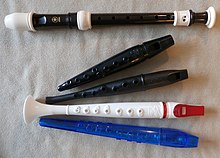Tonette

The Tonette is a small, end-blown flute made of plastic, which was once popular in American elementary music education. Though the Tonette has been superseded by the recorder in many areas, due to their price, durability and simplicity, plastic Tonettes are still in use in elementary schools around the nation. The range of the Tonette is from C5 (C above middle C) to D6, although sheet music is notated one octave lower. Similar instruments are the Song Flute,[1] Flutophone,[2] and Precorder.
The Tonette was introduced in 1938. Designed as a pre-band instrument, the tonette was nearly unbreakable, chromatic, and tunable. It was easy to blow and the fingering was simple. By 1941 over half of the grammar schools (equivalent to UK primary school, not UK grammar school) in the United States had adopted the Tonette as standard pre-band equipment. The Tonette's pleasant flute-like sound was also used for special novelty effects in radio, television and film.
In World War II the armed services found the Tonette to be an inexpensive and entertaining way for idle troops to pass the time.
Peter Schickele has described the tonette as "a cheap, synthetic recorder with amusing pretensions"; it is one of the instruments featured in the Gross Concerto by P. D. Q. Bach.
This instrument was played by Felix Pappalardi on "Pressed Rat and Warthog" on Cream's "Wheels of Fire" album.
References
- ^ Newton, Dwight. "Fitchhorn Song Flute". mewzik.com. Retrieved 2015-08-01.
- ^ Estrella, Espie. "Profile of the Flutophone". musiced.about.com. Retrieved 2014-04-07.
External links
